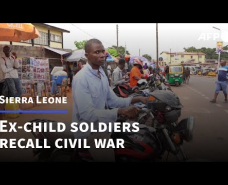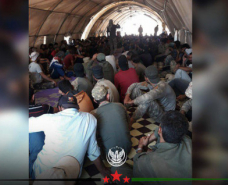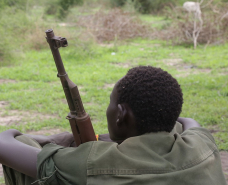With conflict raging in South Sudan, recruitment of children into armed groups is on the rise

Photo: Eye Steel Film
5 May 2014: UNICEF has received credible reports an estimated 9,000 children have been recruited into armed forces and groups by both sides in the conflict in South Sudan.
These reports are based on observations of children with armed groups, children wearing military uniforms and carrying weapons, and children undergoing military training. Under both international and South Sudanese law, the forcible or voluntary recruitment of persons under the age of 18, whether as a member of a regular army or of an informal militia, is prohibited.
Immediate and long-term damage – physical and psychological – is done to children and communities when children are recruited. Children have fought in armed groups in southern Sudan over the past few decades; as a result, they have missed out on their education and grown up in a culture of conflict.
The following story of a former child member of armed groups highlights the immediate dangers as well as the long-term consequences for children who are forced to fight in conflicts not of their making.
By Christopher Tidey
JUBA, South Sudan, 5 May 2014 – Ring Placido is a slight, soft-spoken 23-year-old who exudes warmth and a cheery calm. He is a renowned singer and bandleader in Juba’s burgeoning reggae music scene. His gigs around town draw sell-out crowds, and he has been invited to perform in the UK and Asia. Ring is a budding star.
He is also a former child combatant.
Ring was born in military barracks to a Sudan People’s Liberation Army (SPLA) colonel and his wife. In 1994, when Ring was 6 years old, a rebel group attacked the barracks and abducted him along with a number of other children. He was taken to a village far from his home and made a member of the rebel’s so-called children’s battalion or ‘Nyony’.
“I was very frightened and upset to be taken from my mother,” Ring recalls. “But I could not show fear or sadness, because they would have beaten me. I had no choice but to become one of them.”
Anger and resentment
Over the next four years, Ring was forced to fight for the rebels, who liked to make the children run ahead as the advance front line to draw out enemy fire. By the time Ring was 10, he had fought in three major battles. Ring says, “I had such anger and resentment inside because they made me fight.”
In 1998, Ring escaped and eventually found his way home to his mother and father. Not two years later, however, Ring was again forcibly recruited – this time to the ranks of the SPLA, where he was used as a radio operator until the National Disarmament, Demobilization and Reintegration Commission (NDDRC) secured his release in 2009.
Ring had essentially spent 11 of his 18 years as a member of an armed group.
New fighting, new recruitment
Part of South Sudan’s 30-year legacy of conflict has been the recruitment of children into armed groups – both those forced to fight among the ranks and those made to fulfil support functions like porters, cooks or radio operators. Until the 2005 Comprehensive Peace Agreement (CPA) ended the fighting between the SPLA and the Government of Sudan, children were actively enlisted, either by choice or force, into the SPLA and other armed groups.
South Sudan’s independence from the North in 2011 was heralded as the dawning of a new era of peace, hope and opportunity. In the nearly 10 years following the CPA, the number of recruited children steadily declined, largely through the efforts of the NDDRC, with support from UNICEF. By late 2012, some 4,000 children had been released, returning to their families and communities.
Now, nearly three years on from its emergence as the world’s newest state, South Sudan has once again been plunged into violent conflict, mass displacement and human suffering. In the fighting between Government forces and various opposition groups, the recruitment of children is again on the rise, with an estimated 9,000 children who have been recruited into armed forces and groups by both sides in the.
ing knows all too well what these children are going through. “What’s happening now is wrong,” he says. “Children should be in school learning to think, not in military uniforms learning to fight. Because of my time fighting, I didn’t go to school, and this has made it hard for me and others like me to find a good job as an adult. We were left behind. Still, I was lucky to get out when I did, because I would probably be dead by now if I hadn’t.”
Complex issue
Andrew Holt of the NDDRC agrees with Ring’s assessment. “South Sudan has known violence and war for more than twenty years,” he says. “Children born during this era are as apt to know how to handle a gun as they are to read and write.”
Child recruitment in South Sudan is a complex issue, because much of it is rooted in the country’s devastating poverty. “Children are generally recruited for one of two reasons,” explains Holt. “Either they have been abducted from communities and forced into service; or they are encouraged to join by their families. Children falling under the latter category tend to come from extremely poor households without the means to properly care for them. Parents may see recruitment as an opportunity to ensure their child is fed and sheltered.”
Whatever the cause, the recruitment of children into armed groups is a grave violation of children’s rights, including their fundamental rights to wellbeing, safety and education. Recruitment further threatens their chance for a successful future. That is why UNICEF and the NDDRC are working not only to disarm and demobilize children recruited into armed groups, but also to ensure they have access to education and training upon their release. Demobilized children in South Sudan generally have little to no formal education and are in need of remedial courses or vocational training.
“We owe it to these children to make every effort to find and demobilize them and provide them with opportunities for education and training,” says Ring. “Those of us who have been child soldiers, we can only transform through knowledge. Take us out, but give us school.”
Source: UNICEF
Countering Military Recruitment

WRI's new booklet, Countering Military Recruitment: Learning the lessons of counter-recruitment campaigns internationally, is out now. The booklet includes examples of campaigning against youth militarisation across different countries with the contribution of grassroot activists.
You can order a paperback version here.








